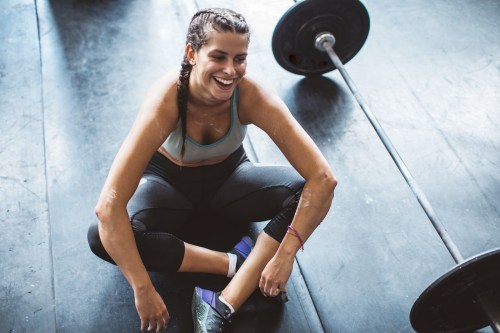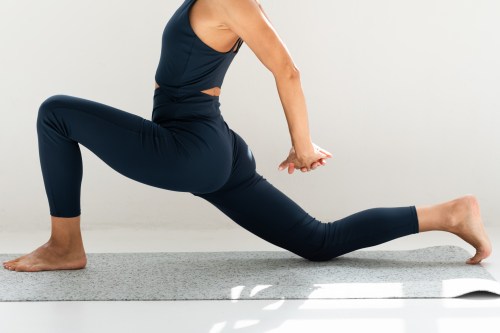Anyone who wants to get in the best possible workout in the shortest period of time is probably a fan of high-intensity interval training (HIIT). In 30 minutes or less, you can bang out a full-body workout that leaves you completely breathless, leaving plenty of time to make it to work on time or simply enjoy the rest of your day. There’s just one thing to remember: If you’re not careful during the high-energy sweat sessions, you could seriously hurt yourself.
While HIIT is by far one of the best ways to reach your fitness goals, it can do harm if your body isn’t ready for those high-intensity movements. If you start whipping out exercises like burpees and jump squats with minimal rest without the basic strength required to do them correctly, the end result isn’t going to be pretty.
“Many people get injured during HIIT exercises because they lack the adequate strength, mobility, or stability in their muscles and joints,” says Emily Samuel, a trainer at New York City’s Dogpound. “Taking someone very deconditioned and immobile and having them do dynamic or high-intense exercises is a recipe for disaster. Many people that sign up for HIIT classes and want to get a great sweat in don’t realize that they need a baseline strength before preforming the dynamic and intense moves properly and safely.”
And even if you’re already in pretty good shape, you’re still not totally safe from injury. Because of the fast pace, it’s not uncommon to get sloppy along the way. What results are three of the most common HIIT-related injuries: shoulders, knees, and ankles. Here’s exactly how to protect those vulnerable areas during your next workout so you can reap the benefits without any lasting pain.
How to protect your knees
1. Make sure correct form is top priority
“Oftentimes, when people squat or lunge, their heel comes off the ground and they push off their toes. This recruits the quadriceps muscles instead of the hamstrings and glutes and can also cause knee strain.” —Eric Rakofsky, director of fitness at The Well
2. Focus on safe landing
“To protect your knees during HIIT, it’s important to land safely during any plyometric movement. When completing vertical jumps, for example, focus on carefully landing on the balls of your feet first, then putting the heel down with control, descending into a squat to decelerate. Landing on your heels potentially sends a shock through your joints and increases the risk of injury.” —Gerren Liles, Hyperwear trainer and master instructor at Equinox
3. Never lock out
“To protect your knees, you never want to lock them. You always want to absorb the impact or weight with a soft knee. Let the lower half of your body be fluid and allow for your hips and core to do the majority of the work when it comes to lower body complex movements like pivots or jumps. Stretching correctly is important, too. Make sure all the muscles surrounding your knees are warmed up.” —Rebecca Rivera, trainer at EverybodyFights
How to protect your ankles
1. Do a proper warm-up
“Ankles are one of the main points for injury during HIIT training. Before you start the workout, adequately warm up your calves and do any mobility and stretching drills you can at the ankle joint. Many ankle injuries occur in the frontal (lateral) or transverse (rotational, twisting) plane, so any exercises that train you to rotate or move laterally with skill will help you react better, improve proprioception, and minimize the potential for injury.” —Gerren Liles
2. If it doesn’t feel good, don’t do it
“Lack of ankle mobility is more common than you think. To prevent injury, I like to go back to basics. If it doesn’t feel good, don’t do it—like jumping or any over-extending. It’s not necessary to push yourself to that extent. Also going back to the warm-up. The warm-up is so, so, so, so essential.” —Rebecca Rivera
3. Harness your cat-like landing skills
“Many HIIT classes incorporate jumping movements. Knowing how to jump and land properly is crucial for the longevity of your ankles. Explode off the ground, but land softly—like a cat! The balls of your feet should be the last thing to leave ground when you jump and the first thing to touch it when you land.” —Eric Rakofsky
How to protect your shoulders
1. Don’t lift too much, too often
“One of the best ways to prevent injury in your shoulders is to be mindful of how much and how often you’re lifting any load overhead during a workout or program. Workouts that include a lot of overhead pressing, for example, can be very taxing on them and should be limited whenever possible. Remember that the shoulders usually assist larger muscle groups during exercises, so when they get weak, it makes performing complex and compound movements more ineffective and dangerous.” —Gerren Liles
2. Speak up if you need a modification
“Shoulder injury is the most common injury I see as a trainer. Your shoulder muscle should be more of a stabilizer and not the primary ‘mover’ for a lot of exercises. Some people are afraid to speak up if they need a modification and go right into the exercise with full-body force. This is how a lot of people get hurt. There are many factors and situations that cause shoulder injuries, but the primary preventative is obviously to warm-up, use correct form, and stop when it doesn’t feel good.” —Rebecca Rivera
3. Focus on proper alignment
“If you’re working on strengthening your shoulders, mobility is just as important. Most people lack decent shoulder mobility, and when they’re pressing a weight above their head it’s quite easy to lose control. A helpful pointer is to remember to align the weight with your body once it’s overhead. You want the weight to be stacked with your vertebrae. Think about hiding your ear with your biceps to ensure you’re in a straight line.” —Eric Rakofsky
Here’s how much time you should actually devote to a HIIT workout. And you might want to upgrade your sneakers.
Sign Up for Our Daily Newsletter
Get all the latest in wellness, trends, food, fitness, beauty, and more delivered right to your inbox.
Got it, you've been added to our email list.











